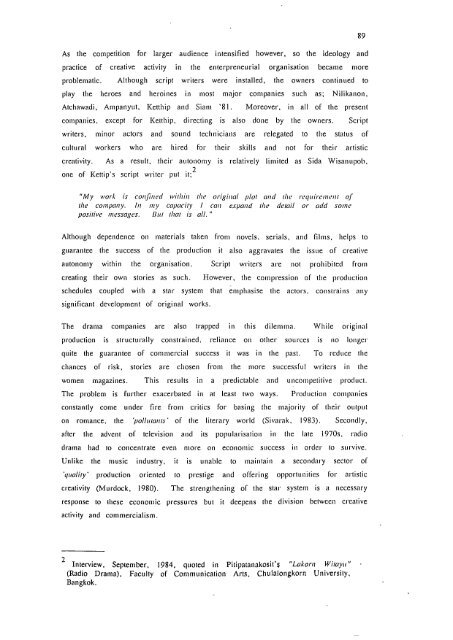iieiiei1eWrkers - Leicester Research Archive - University of Leicester
iieiiei1eWrkers - Leicester Research Archive - University of Leicester
iieiiei1eWrkers - Leicester Research Archive - University of Leicester
You also want an ePaper? Increase the reach of your titles
YUMPU automatically turns print PDFs into web optimized ePapers that Google loves.
As the competition for larger audience intensified however, so the ideology and<br />
practice <strong>of</strong> creative activity in the enterpreneurial organisation became more<br />
problematic. Although script writers were installed, the owners continued to<br />
play the heroes and heroines in most major companies such as; Nilikanon,<br />
Atchawadi, Ampanyut, Ketthip and Siam '81. Moreover, in all <strong>of</strong> the present<br />
companies. except for Ketthip, directing is also done by the owners. Script<br />
writers, minor actors and sound technicians are relegated to the status <strong>of</strong><br />
cultural workers who are hired for their skills and not for their artistic<br />
creativity. As a result, their autonomy is relatively limited as Sida Wisanupob,<br />
one <strong>of</strong> Kettip's script writer put it;2<br />
"My work is confined within the original plot and i/ic require/lie/it <strong>of</strong><br />
the company. In my capacity I can expand the detail or add SO/flC<br />
positive messages. But thai is all.<br />
Although dependence on materials taken from novels, serials, and films, helps to<br />
guarantee the success <strong>of</strong> the production it also aggravates the issue <strong>of</strong> creative<br />
autonomy within the organisation. Script writers are not prohibited from<br />
creating their own stories as such. However, the compression <strong>of</strong> the production<br />
schedules coupled with a star system that emphasise the actors, constrains any<br />
significant development <strong>of</strong> original works.<br />
The drama companies are also trapped in this dilemma. While original<br />
production is structurally constrained, reliance on other sources is no longcr<br />
quite the guarantee <strong>of</strong> commercial success it was in the past. To reduce the<br />
chances <strong>of</strong> risk, stories are chosen from the more successful writers in the<br />
women magazines. This results in a predictable and uncompetitive product.<br />
The problem is further exacerbated in at least two ways. Production companies<br />
constantly come under fire from critics for basing the majority <strong>of</strong> their output<br />
on romance, the 'pollutants' <strong>of</strong> the literary world (Sivai'ak, 1983). Secondly,<br />
after the advent <strong>of</strong> television and its popularisation in the late I 970s. radio<br />
drama had to concentrate even more on economic success in order to survive.<br />
Unlike the music industry, it is unable to maintain a secondai'y sector <strong>of</strong><br />
'quality' production oriented to prestige and <strong>of</strong>fering opportunities for artistic<br />
creativity (Murdock, 1980). The strengthening <strong>of</strong> the stai' system is a necessary<br />
response to these economic pressures but it deepens the division between ci'eative<br />
activity and commercialism.<br />
2 Interview, September, 1984, quoted in Pitipatanakosil's "Lakorn Witayu"<br />
(Radio Drama), Faculty <strong>of</strong> Communication Arts, Chulalongkorn <strong>University</strong>,<br />
Bangkok.<br />
89














